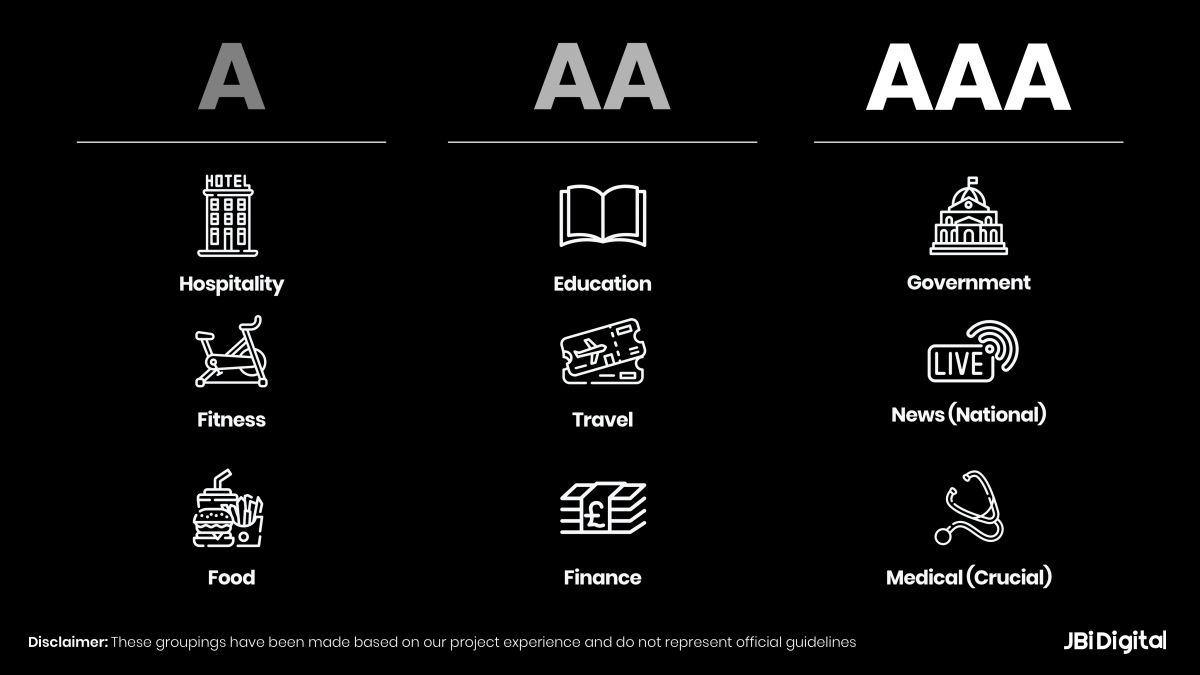Web accessibility has become an increasingly important aspect of web design and development in recent years and there is plenty of intrigue surrounding the subject.
If your company is planning to revamp its website, accessibility should be high on your list of considerations.
Why? Because the more accessible your product is, the more of your audience it will be able to reach – even at a basic level of compliance.
This guide – written to mark Global Accessibility Awareness Day 2021 – will help you to understand web accessibility and decide whether or not it is a worthwhile investment for your website.

In simple words, complying with accessibility standards will ensure that your product – whether it is a simple brochure website, an application or an online shop – is designed and built in a way that makes it accessible for all users, whatever their hardware, software, language, location, or ability.
Effective web accessibility will ensure that users with various limitations are able to access and use your service, including:
- Visual limitations: Users who are severely sight impaired (blind), sight impaired (partially sighted) or colour blind
- Hearing limitations: Users who are deaf or hard of hearing
- Mobility limitations: Users who find it difficult to use a mouse or keyboard
- Thinking and understanding limitations: Users with dyslexia, autism or learning difficulties
- Situational limitations: Users limited by their circumstance (on a moving train, using poor or unstable internet connection, etc.)
- Environmental limitations: Users limited by their surroundings (noisy room, bright light shining on device screen, etc.)
Providing a service which considers and accommodates such users will not only reflect well on your organisation for its efforts towards inclusion – it will also maximise your reachable audience.
In addition, Google’s algorithm prefers websites which follow accessibility best practices, so the higher your level of accessibility, the better your website will perform on search.

In terms of assessment, a website’s level of accessibility is judged by its compliance with WCAG 2.1 (Web Content Accessibility Guidelines).
This is a government-approved series of guidelines which helps content creators, designers and developers to improve web accessibility standards across the digital space.
Compliance with these guidelines is measured across three levels: A, AA and AAA.
More on that later…

The UK Government has introduced accessibility regulations to ensure that public sector websites and mobile apps are built in such a way that they exclude as few users as possible.
These regulations came into effect in 2018 and required all public bodies to meet the international WCAG 2.1 AA accessibility standard as a minimum by September 2020.
This prompted a push for improved accessibility across the digital space, trickling down from local government and public bodies to sectors like travel and education.
2020 was a year defined by enhancements to accessibility in the UK digital space and beyond. COVID-19 and the healthcare crisis gave many organisations no choice but to focus on making much needed improvements to their digital platforms in order to meet growing online demand.
This has carried over into 2021 and made accessibility one of the fastest growing trends in the digital industry.
“It has become crucial that businesses have relevant and up-to-date websites which offer a great user experience to all, including those with disabilities and other limitations.”
Raj Bawa, Operations Director at JBi Digital

Making your website accessible will not only reflect well on your business; it will also ensure that you are maximising your audience and ranking highly on search.
But the truth is that – unless you are a public body – nothing is forcing your website to comply with accessibility standards.
It is very important that you explore the potential benefits of doing so, especially if you are looking to redesign your website or refresh your online presence.
In order to determine the right level of accessibility for your website, we would advise carrying out an internal audit which involves your project teams and key stakeholders. It may also add value to consult your digital agency or approach an accessibility specialist.
The audit should include a cost-benefit analysis which takes into consideration your audience (who they are, where they use your product, what devices they use and how they use them) and your service offering (how crucial your digital product is to everyday users, whether or not there are other ways for users to benefit from your services).
Depending on the results of your audit, you should be well placed to decide which of the WCAG’s three compliance levels your website needs to attain:

- Level A – the most basic web accessibility features, designed to go hand-in-hand with the best practices for website design and development.
- Level AA – mandated for public bodies, this level of compliance will remove the most common barriers for disabled users, significantly improving your product’s user experience.
- Level AAA – the most comprehensive level of web accessibility, targeted by organisations which offer crucial public services through their digital products.
For more detail on each of these compliance levels and some business-led case studies, read on…

To help you identify the level of accessibility that is appropriate for your organisation, we have put together the following case studies for each classification.
It should be noted that these are based purely on our project experience and should not be used to directly inform your decision.
Private Sector SME (LEVEL A)
- Website purpose: To inform prospective clients / consumers who want to find out more about the product / service on offer.
- Legal obligation to comply: None.
- Cost to implement: Roughly 10-15% of project cost.
- Benefits: Complying with WCAG 2.1 A will ensure that the SME’s service is accessible to all sections of its audience online, while also bringing SEO benefits and reflecting positively on the business as a whole. Finally, doing so will build a strong base of accessibility should the company ever need to upgrade to AA compliance.
Achieving a basic level of website accessibility is easier than it may seem. Most web accessibility guidelines are designed to go hand-in-hand with the best practices for website design and development.
In simple terms, complying with WCAG level A is a great way to make progress and begin to serve as many of your users as possible. In an ideal world, all websites should follow this standard as a minimum.
International B2B Company Providing Online Service (LEVEL A+ / AA)
- Website purpose: To provide an online service which cannot be accessed anywhere else.
- Legal obligation to comply: None.
- Cost to implement: Roughly 15-20% of project cost, although this could be reduced by complying fully with WCAG 2.1 A and then cherry picking beneficial aspects of AA to attain (A+).
- Benefits: Will maximise the audiences that are able to access the company’s services, while boosting search rankings and demonstrating the company’s commitment to inclusivity.
Complying with AA accessibility standards will require additional functionality, such as video captioning and alternative features, so it is very important that private companies carry out a detailed cost-benefit analysis to ensure that doing so would make business sense.
It could be that, as in this case study, complying fully with WCAG 2.1 A and taking on some key aspects of WCAG 2.1 AA would be the most beneficial approach.
Public Sector Organisation (LEVEL AA)
- Website purpose: To provide a public service.
- Legal obligation to comply: Mandated by law to comply with WCAG 2.1 AA.
- Cost to implement: Roughly 20-25% of project cost.
- Benefits: Compliance with government regulation!
Ultimately, public bodies have no option but to comply with WCAG 2.1 AA at a minimum.
This is an expensive process, but will ensure that their service is available and accessible to as many users as possible.
Crucial National Service (LEVEL AA+ / AAA)
- Website purpose: To provide the general public with access to an essential public service.
- Legal obligation to comply: None (only required to comply with AA by law).
- Cost to implement: Roughly 30% of project cost.
- Benefits: Full audience access to service.
For the largest and most essential public bodies, such as the NHS and Gov.uk, aspiring to WCAG 2.1 AAA is an important step in ensuring that their websites are entirely inclusive.
However, full compliance with AAA standards is very rare and expensive – most such organisations will choose to take on some aspects of WCAG 2.1 AAA, while remaining fully compliant with AA.
“Every situation is unique; your website’s required level of accessibility will come down to your organisation’s individual service and audiences.”
David Gelb, Managing Director at JBi Digital
Have we helped?
If you’ve made it this far, we hope that you’ve learned a lot about the basics of accessibility!
At JBi, every product that we build meets WCAG level A requirements as a minimum. In recent years, we have helped many of our clients – from both the public and private sectors – to meet AA standards.
Accessibility is at the heart of our vision to improve the digital space and make it accessible to all.
If you have a project you would like to discuss with us – whether its accessibility related or not! – please don’t hesitate to send your brief to hello@jbidigital.co.uk or call us on 0207 043 2510.




